I'm having a problem, which I can't figure out for the life of me. I've searched the internet, trying to understand Swifts's EXC_BAD_ACCESS, but nothing seemed to help.
The following code is quite long, but most of the time the comments are all the information needed to understand the item of relevance.
I have a class CalculatorController, which contains the following relevant methods and properties:
import UIKit
class CalculatorController: UIViewController {
// the actual `@IBOutlet` which is never accessed directly
@IBOutlet private weak var _mainDisplay: UILabel!
// an instance of `MainDisplayMicroController`
// holds a reference to `_mainDisplay`
// is used to manipulate `_mainDisplay` in a controlled way
private var mainDisplay: MainDisplayMicroController!
override func viewDidLoad() {
super.viewDidLoad()
// connects `mainDisplay` with `_mainDisplay`
mainDisplay = MainDisplayMicroController(label: _mainDisplay)
// sets `_mainDisplay`'s `text` property to "0"
mainDisplay.content = .Number(0)
//...
}
//...
}
In order to manage _mainDisplay in a certain way, I have created a class MainDisplayMicroController, which on the one hand contains a reference to the the UILabel itself, and on the other hand contains methods and properties, which perform actions on the UILabel:
import UIKit
class MainDisplayMicroController {
// used to express what `label.text` is currently showing
private enum DisplayState {
case ShowingNumber
case ShowingConstant
case ShowingErrorMessage
case Unknown
}
// holds the current state of what `label.text` is showing
private var state = DisplayState.Unknown
// used to pass different types of values in and out of this class
enum ContentType {
case Number(Double)
case Constant(String)
case ErrorMessage(String)
case Unknown(Any?)
}
// holds the reference to the label which is being manipulated/managed
private var label: UILabel?
// makes `label`'s `text` property directly accessible, as `label` is `private`
var text: String? {
get {
return label?.text
}
set {
label?.text = newValue
removeLeadingZeros()
transformToInteger()
}
}
// a property to allow controlled retrieval and manipulation of `label.text`
// uses `ContentType` to make clear what the information in `label.text` is/ is supposed to be
var content: ContentType {
get {
switch state {
case .ShowingNumber:
if let string = text {
if let value = NSNumberFormatter().numberFromString(string)?.doubleValue {
return .Number(value)
}
}
case .ShowingConstant:
if let symbol = text {
return .Constant(symbol)
}
case .ShowingErrorMessage:
if let message = text {
return .ErrorMessage(message)
}
default:
break
}
state = .Unknown
return .Unknown(text)
}
set {
switch newValue {
case .Number(let value):
text = "\(value)"
state = .ShowingNumber
removeLeadingZeros()
transformToInteger()
case .Constant(let symbol):
text = symbol
state = .ShowingConstant
case .ErrorMessage(let message):
text = message
state = .ShowingErrorMessage
case .Unknown(let thing):
text = "Error: Passed unknown value: \(thing)"
state = .ShowingErrorMessage
}
}
}
// removes the ".0" from `label.text`, if it is a whole number
private func transformToInteger() {
if state == .ShowingNumber {
switch content {
case .Number(let value):
if round(value) == value {
var doubleString = "\(value)"
if doubleString.rangeOfString("e") == nil {
dropLast(doubleString)
dropLast(doubleString)
}
text = doubleString
}
default:
break
}
}
}
// removes leading "0"s from `label.text` if they are redundant
private func removeLeadingZeros() {
if state == .ShowingNumber {
switch content {
case .Number(let displayedValue):
content = .Number(displayedValue)
default:
break
}
}
}
//...
}
Now, when I run the code I get the following error:

From what I've read on EXC_BAD_ACCESS, the error often occurs when trying to call methods on released objects. I've tried using NSZombieto check the issue, but I didn't find anything (probably due to my incompetence when using NSZombie).
If I try to follow what is happening by logic, I come to following conclusion:
mainDisplayis set successfully inviewDidLoad()mainDisplay.contentis called- in the
content's setter the switch-statement executes the.Numbercase textandstateare successfully setremoveLeadingZeros()is called- the switch-statement accesses
content's getter - the switch-statement in
content's getter executes the.ShowingNumbercase - the if-statements resolve to true, finally trying to evaluate the
NSNumberFormatterexpression - the
EXC_BAD_ACCESSoccurs
Does anyone know why this is happening? Does it have to do with me manipulating an @IBOutlet in a different class?
Any help is greatly appreciated!
Here are links to the complete CalculatorController and MainDisplayMicroController.
Update #1:
As @abdullah suggested I have tried directing the NSNumberFormatter expression in to multiple expressions. I still get the error though:

Update #2:
I've removed all references and external classes, to make it as simple as possible, while maintaining the same functionality.
All of the methods and properties defined in MainDisplayMicroController have been moved to CalculatorModel.
These methods and properties now access the original @IBOutlet, not any reference to it.
But still when trying to run it I get EXC_BAD_ACCESS(code=2) at the same line of code.
I'm just super confused, as it can't have anything to do with weird references, or objects being released too soon anymore.
Here's the complete code for the new CalculatorController.
Update #3:
I've removed the NSNumberFormatter line, by changing it to:

Now I get the following error though:

I assume there's some fundamental problem with the code, so I'm scrapping it. But thanks for all the help, and attempts at figuring this out.
Update #4:
This is what I get when adding a breakpoint on throw for all exceptions:
